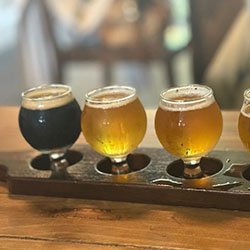It’s about an hour by plane from where I had been staying in Taupo. The bus takes around five hours.
I decided to take the bus. The streets around Wellington Station were stylish and compact. Every kind of shop you could think of was in the city, along with numerous companies, museums, even Parliament buildings—all in an area you could cover on foot. It had to be a convenient place to live. The buildings had an artistic look, and seemed to be in harmony with the nearby oceans and mountains. It left a wonderful impression on me.
One of the things that drew me to Wellington was yoga. Just as yoga has caught on in Japan, there are numerous yoga studios in New Zealand’s cities and towns as well.
One of the yoga studios I looked into before visiting Wellington was located in the middle of the city. I booked a hostel about a five-minute walk from there so that I could get home safely even if the class ran late. People tend to think of yoga as primarily a women’s activity in Japan, but that’s not actually the case. The yoga studio I frequent has local people of all ages, about half male and half female. When they heard I was visiting from Japan, the staff smiled and were kind to me, which made me really happy.
In this studio, they had meditation time in addition to yoga. The main draws of this place and the reason I chose it were that I’d been interested in taking a meditation class in addition to yoga, and because they offer vegan food after the class. Eating out is expensive in New Zealand (as it is in Australia), so being able to get some delicious vegan food for another five dollars was enough to make me want to go there every day.
You could take up to four classes a week without a reservation. They offered two or three classes a day, and you could eat after they were over. Of course you could just go home after class, and you could also come just to eat the vegan food offered afterwards. I had a great time chatting with the different people there over a meal. Everyone, including the yoga teachers and staff, was approachable and warm.
I made friends with the staff during my regular visits, and when I heard them ask if anyone could volunteer to help prepare the vegan food, I offered. I took on quick, easy jobs like food prep and setting the table. I was amazed that they could make such delicious food without meat, fish, or eggs—it was truly a valuable experience for me. It was a place where you heard “thank you” every day, and I’ll never forget being showered with everyone’s genuine smiles.
I wonder whether yoga has just become a natural part of everyday life in New Zealand. The hostel I stayed at had yoga mats available, but I only saw anyone use them once while I was there. Maybe that’s because the people staying there were almost all foreign tourists.
I actually saw yoga signs everywhere when I walked around the city of Wellington. I decided to try out a different studio that a local friend had told me about. Every studio has different pricing and systems. I signed up for a class that they held by donation every Sunday. You didn’t need a reservation, but you did have to fill out a health checklist and sign before taking the class. Donations were accepted in cash as well as by debit or credit card, and it seemed like most people were using debit cards. You just told them how much you wanted to give and they’d charge you right there. According to my friend, ten dollars was a typical minimum amount. The class was about 90 minutes, with so many students filling the studio that we were suddenly crammed in there like sardines. The instructor talked a bit before class, and they also gave us five minutes to chat with the people next to us. It was a small thing, but I felt like just saying hi and chatting a bit with the strangers next to us changed the atmosphere and helped us relax and enjoy the yoga more. I thought it was a great idea.
Wellington is famous for being windy, and the weather changes dramatically throughout each day. The weather report doesn’t do much good. Unlike in Japan, you rarely see people with umbrellas even in the rain. Instead, they have raincoats or jackets with hoods. I also thought it was interesting that while some people were wearing thermals with down over them like I was, there were other people walking around in short sleeves, shorts, and sandals. I’m not exactly sure what they call the season now, but since it’s the opposite of Japan, it’s got to be winter—right? I guess that just shows you how differently people experience temperature.
The city of Wellington is also conveniently located close to the airport, making it easy to get to. There are several stops along a bus route that goes directly to the airport, with buses coming by every ten or fifteen minutes. It takes less than thirty minutes to get there if traffic conditions are good. The locations of the stops are clearly marked with lighted signs telling you how many minutes until the next bus—making you sure that a bus is coming while you wait. Having the airport so close was a lifesaver with the heavy bags you need when you’re traveling abroad. It was so easy to just travel from the city on a single bus. Wellington definitely gets high marks for overseas travel.
Another thing was that the museums were free, and the streets were relatively safe. The food was great…the city had a lot of pluses. A New Zealander friend of mine who has lived in Japan for a long time told me that the soft-serve ice cream at McDonald’s was better in New Zealand than anywhere else in the world. I guess the milk they use is different, but you have to eat it to know. I was curious enough that I had to try. I thought it was delicious—very thick and rich. It was also reasonably priced, so to be honest I was pretty hooked. They had a chocolate-coated one and a limited-edition banana pie soft-serve that were particularly good.
I’ve actually never even tried the soft-serve ice cream at McDonald’s in Japan, but when I go back, I’m definitely going to get some to see if I can tell the difference.

































































